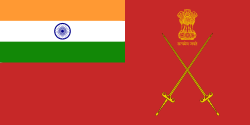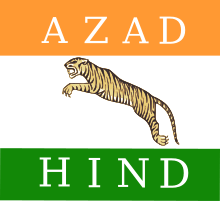Dogra Regiment
| The Dogra Regiment | |
|---|---|
|
Regimental Insignia of the Dogra Regiment | |
| Active | 1877 - Present |
| Country |
|
| Branch | Indian Army |
| Type | Line Infantry |
| Regimental Centre | Faizabad, Uttar Pradesh |
| Motto(s) | Kartavyam Anvatma (Duty Before Death) |
| War Cry | Jwala Mata Ki Jai (Victory to Goddess Jwala) |
| Decorations |
One Ashoka Chakra nine Maha Vir Chakras four Kirti Chakras four Yudh Seva Medals 36 Vir Chakras one Vir Chakra and Bar one Padma Bhushan 11 Uttam Yudh Seva Medals five Param Vishisht Seva Medals 13 Ati Vishisht Seva Medals 17 Shaurya Chakras 119 Sena Medals 21 Vishisht Seva Medals 188 Mention-in-Despatches and 263 COAS's Commendation Cards |
| Battle honours |
Jhangar, Rajauri, Uri, Asal Uttar, Haji Pir, Raja Picquet, OP Hill, Siramani, Suadih, Dera Baba Nanak and Chandgram
Theatre Honours |
| Commanders | |
| Notable commanders | General Nirmal Chander Vij |
| Insignia | |
| Regimental Insignia | Tiger revered as the mount of the Goddess Durga, who is a widely worshipped deity in the Dogra Hills |
The Dogra Regiment is an infantry unit of the Indian Army, formerly the 17th Dogra Regiment when part of the British Indian Army.
History
Formation
The regiment recruits from the Dogra people of Jammu and Kashmir, Himachal Pradesh and the hill regions of Punjab. The current regiment was formed in 1922 through the amalgamation of three separate regiments of Dogras as the 17th Dogra Regiment. They were:
- 1st Battalion - Formerly the 37th (Prince of Wales's Own) Dogras
- 2nd Battalion - Formerly the 38th Dogras
- 3rd Battalion - Formerly the 1st Battalion, 41st Dogras
- 10th (Training) Battalion - Formerly the 2nd Battalion, 41st Dogras
The 41st Dogras were an infantry regiment of the British Indian Army. It could trace its origins to 1900, when it was raised as the 41st (Dogra) Bengal Infantry. After World War I, the Indian government reformed the army, moving from regiments with a single battalion to multi battalion regiments.[1] It dropped '17th' from its title in 1945 and was allocated to India upon its independence in 1947.
Enlisting in the army is seen as an honourable pursuit for Dogras, with the earnings of the soldiers of the regiment forming a sizeable part of the local economy. The regiment currently has 18 battalions. The 1st Battalion was reroled in 1981 to become the 7th Battalion, Mechanised Infantry Regiment.
Soldiering has not only become a substantial part of the economic structure of the Dogra Hills, but created social and cultural traditions built on the people's association with the army. The regiment has produced one Army Chief, General Nirmal Chander Vij. The General also served as the 10th Colonel-in-Chief of the Dogra Regiment and the Dogra Scouts.
In the pre-Independence era, the Dogras had to their credit three Victoria Crosses and 44 Military Crosses besides 312 other awards. Two battalions of the 17th Dogra Regiment (the 2nd and 3rd), also fought in the Malayan Campaign. After the Fall of Singapore, a large number of the captured troops later went on to join the Indian National Army.[2]
Units
- 2nd Battalion
- 3rd Battalion
- 4th Battalion
- 5th Battalion
- 6th Battalion
- 7th Battalion
- 8th Battalion
- 9th Battalion
- 10th Battalion (DBN)
- 11th Battalion
- 12th Battalion
- 13th Battalion
- 14th Battalion
- 15th Battalion
- 16th Battalion
- 17th Battalion
- 18th Battalion
- 19th Battalion
- 20th Battalion[3]
Battle honours
Pre-Independence combined battle honours of 37th (Prince of Wales's Own) Dogras, 38th Dogras, 41st Dogras:
- The Great War: La Bassée 1914, Festubert 1914-1915, Givenchy 1914, Neuve Chapelle, Aubers, France and Flanders 1914-15, Egypt 1915, Megiddo, Nablus, Palestine 1918, Tigris 1916, Kut al Amara 1917, Baghdad, Mesopotamia 1915-18, Aden, NW Frontier India 1915-1917
- Afghanistan 1919
- The Second World War: Kota Bahru, Malaya 1941-42, Donbaik, Nunshigum, Magwe, Kennedy Peak, Burma 1942-45
Post Independence
- Jhangar, Rajauri, Jammu and Kashmir 1947-48, Hajipir, Raja Picquet-Chand Tekri, OP Hill (NL 1053), Jammu and Kashmir 1965, Asal Uttar, Dograi, Punjab 1965, Suadhi, Siramani, Chauddagram, East Pakistan 1971, Dera Baba Nanak, Punjab 1971 where Lieutenant Colonel Narinder Singh Sandhu displayed Valour and Courage and in the true traditions of the Indian Army won The Maha Vir Chakra.
- The Highest Gallantry Award with the Dogra Regiment in post-independence era is the Ashok Chakra that was conferred posthumously to Major Sandeep Shankla in 1992 by then President of India Shri. R. Venkataraman. Maj. Sandeep Shankla belonged to the 18th Regiment of the Dogras.
"The total collapse of the Pakistan Army's resistance is one of the most intriguing puzzles of the war in the East" wrote the Sunday Times on December 7, 1971 as Pakistan surrendered. The credit for the fall of Suadih, a small village but a strong bastion of the Pakistan army's most fortified position in Bangladesh, went to 9 Dogra. This led to the ultimate liberation of East Pakistan and a victory for the Indian Army. For this herculean task, the battalion was awarded the battle honour of Suadih. The Dogra Regiment also fought in 1999 Kargil war for tiger hill mission. which is also called as "OPERATION VIJAY".The 5TH DOGRA Regiment was part of it.


